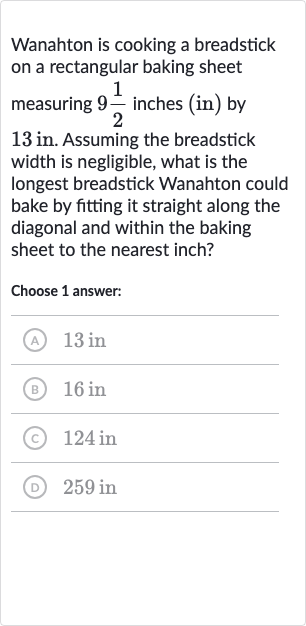AI tutor
Welcome to Bytelearn!
Let’s check out your problem:

Wanahton is cooking a breadstick on a rectangular baking sheet measuring inches (in) by in. Assuming the breadstick width is negligible, what is the longest breadstick Wanahton could bake by fitting it straight along the diagonal and within the baking sheet to the nearest inch?Choose answer:(A) in(B) in(C) in(D) in
Full solution
Q. Wanahton is cooking a breadstick on a rectangular baking sheet measuring inches (in) by in. Assuming the breadstick width is negligible, what is the longest breadstick Wanahton could bake by fitting it straight along the diagonal and within the baking sheet to the nearest inch?Choose answer:(A) in(B) in(C) in(D) in
- Calculate Diagonal Formula: To find the length of the longest breadstick that can fit diagonally within the baking sheet, we need to calculate the diagonal of the rectangle using the Pythagorean theorem. The formula for the diagonal of a rectangle with length and width is .
- Convert to Improper Fraction: First, we need to convert the mixed number inches to an improper fraction to make the calculation easier. inches is the same as inches.
- Apply Pythagorean Theorem: Now we can apply the Pythagorean theorem. The length of the rectangle is inches, and the width is inches. So, the diagonal is calculated as follows:
- Calculate Squares: Let's calculate the squares of the length and width:
- Add Squares: Now, we add the squares of the length and width to find the square of the diagonal:
- Find Square Root: Next, we take the square root of to find the length of the diagonal:
- Estimate Square Root: Since we don't have a perfect square under the square root, we can estimate the square root of . We know that and . So, is between and .
- Estimate Diagonal Length: Given that is closer to than to and , we can estimate the diagonal to be slightly more than inches.
- Round to Nearest Inch: Dividing by gives us , so the diagonal is slightly more than inches. Since we need to round to the nearest inch, the longest breadstick Wanahton could bake to fit diagonally within the baking sheet is approximately inches.
More problems from Volume of cubes and rectangular prisms: word problems
QuestionGet tutor help
QuestionGet tutor help
QuestionGet tutor help
QuestionGet tutor help
QuestionGet tutor help
QuestionGet tutor help
QuestionGet tutor help
QuestionGet tutor help
QuestionGet tutor help
